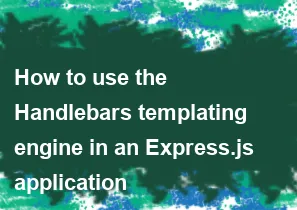How to use the Handlebars templating engine in an Express.js application

Handlebars is a popular templating engine for JavaScript that allows you to create dynamic HTML templates. When used with Express.js, Handlebars enables you to render dynamic content on the server and send it to the client. Here's a step-by-step guide on how to use Handlebars in an Express.js application:
Step 1: Install Handlebars and Express
Make sure you have Node.js and npm installed. Then, in your project directory, run the following commands to install Handlebars and Express:
bashnpm install express handlebars
Step 2: Set up your project structure
Create the basic structure for your Express.js application. Create files like app.js (or any other entry point) and a folder named views to store your Handlebars templates.
goproject-root/
|- views/
| |- index.handlebars
|- app.js
|- package.json
Step 3: Configure Express to use Handlebars
In your app.js file, set up Express to use Handlebars as the view engine:
javascriptconst express = require('express');
const exphbs = require('express-handlebars');
const app = express();
// Set Handlebars as the view engine
app.engine('handlebars', exphbs());
app.set('view engine', 'handlebars');
// Set the path to the 'views' directory
app.set('views', './views');
// Define a route to render the Handlebars template
app.get('/', (req, res) => {
// The second parameter of res.render is an object containing data to be passed to the template
res.render('index', { title: 'Express with Handlebars' });
});
// Start the server
const port = 3000;
app.listen(port, () => {
console.log(`Server is running on http://localhost:${port}`);
});
Step 4: Create a Handlebars template
Create a file named index.handlebars inside the views folder with the following content:
handlebars<!DOCTYPE html> <html lang="en"> <head> <meta charset="UTF-8"> <meta name="viewport" content="width=device-width, initial-scale=1.0"> <title>{{ title }}</title> </head> <body> <h1>{{ title }}</h1> </body> </html>
Step 5: Run your Express.js application
Now, run your Express.js application:
bashnode app.js
Visit http://localhost:3000 in your browser, and you should see the rendered HTML with the dynamic content from the Handlebars template.
This is a basic setup to get you started with Handlebars in an Express.js application. You can explore more features of Handlebars, such as partials, helpers, and more, to build more complex and dynamic templates.
-
Popular Post
- How to optimize for Google's About This Result feature for local businesses
- How to implement multi-language support in an Express.js application
- How to handle and optimize for changes in mobile search behavior
- How to handle CORS in a Node.js application
- How to use Vue.js with a UI framework (e.g., Vuetify, Element UI)
- How to configure Laravel Telescope for monitoring and profiling API requests
- How to create a command-line tool using the Commander.js library in Node.js
- How to implement code splitting in a React.js application
- How to use the AWS SDK for Node.js to interact with various AWS services
- How to use the Node.js Stream API for efficient data processing
- How to implement a cookie parser middleware in Node.js
- How to implement WebSockets for real-time communication in React
-
Latest Post
- How to implement a dynamic form with dynamic field styling based on user input in Next.js
- How to create a custom hook for handling user interactions with the browser's device motion in Next.js
- How to create a custom hook for handling user interactions with the browser's battery status in Next.js
- How to implement a dynamic form with dynamic field visibility based on user input in Next.js
- How to implement a dynamic form with real-time collaboration features in Next.js
- How to create a custom hook for handling user interactions with the browser's media devices in Next.js
- How to use the useSWRInfinite hook for paginating data with a custom loading indicator in Next.js
- How to create a custom hook for handling user interactions with the browser's network status in Next.js
- How to create a custom hook for handling user interactions with the browser's location in Next.js
- How to implement a dynamic form with multi-language support in Next.js
- How to create a custom hook for handling user interactions with the browser's ambient light sensor in Next.js
- How to use the useHover hook for creating interactive image zoom effects in Next.js